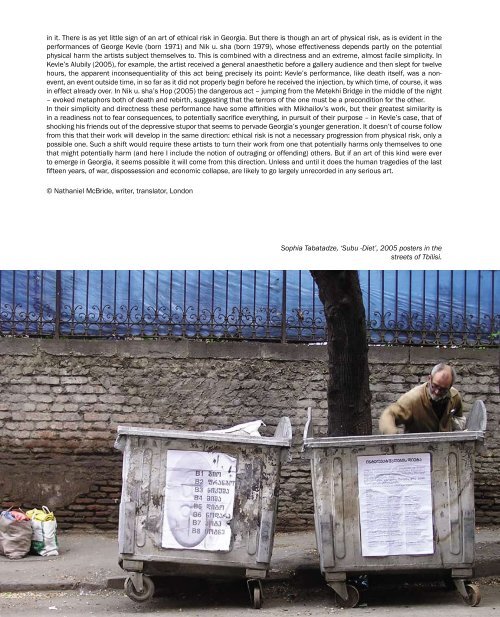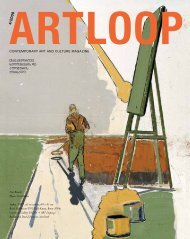xelovnebis saerTaSoriso Jurnali - Artisterium
xelovnebis saerTaSoriso Jurnali - Artisterium
xelovnebis saerTaSoriso Jurnali - Artisterium
You also want an ePaper? Increase the reach of your titles
YUMPU automatically turns print PDFs into web optimized ePapers that Google loves.
in it. There is as yet little sign of an art of ethical risk in Georgia. But there is though an art of physical risk, as is evident in the<br />
performances of George Kevle (born 1971) and Nik u. sha (born 1979), whose effectiveness depends partly on the potential<br />
physical harm the artists subject themselves to. This is combined with a directness and an extreme, almost facile simplicity. In<br />
Kevle’s Alubily (2005), for example, the artist received a general anaesthetic before a gallery audience and then slept for twelve<br />
hours, the apparent inconsequentiality of this act being precisely its point: Kevle’s performance, like death itself, was a nonevent,<br />
an event outside time, in so far as it did not properly begin before he received the injection, by which time, of course, it was<br />
in effect already over. In Nik u. sha’s Hop (2005) the dangerous act – jumping from the Metekhi Bridge in the middle of the night<br />
– evoked metaphors both of death and rebirth, suggesting that the terrors of the one must be a precondition for the other.<br />
In their simplicity and directness these performance have some affinities with Mikhailov’s work, but their greatest similarity is<br />
in a readiness not to fear consequences, to potentially sacrifice everything, in pursuit of their purpose – in Kevle’s case, that of<br />
shocking his friends out of the depressive stupor that seems to pervade Georgia’s younger generation. It doesn’t of course follow<br />
from this that their work will develop in the same direction: ethical risk is not a necessary progression from physical risk, only a<br />
possible one. Such a shift would require these artists to turn their work from one that potentially harms only themselves to one<br />
that might potentially harm (and here I include the notion of outraging or offending) others. But if an art of this kind were ever<br />
to emerge in Georgia, it seems possible it will come from this direction. Unless and until it does the human tragedies of the last<br />
fifteen years, of war, dispossession and economic collapse, are likely to go largely unrecorded in any serious art.<br />
© Nathaniel McBride, writer, translator, London<br />
Sophia Tabatadze, ‘Subu -diet’, 2005 posters in the<br />
streets of Tbilisi.



